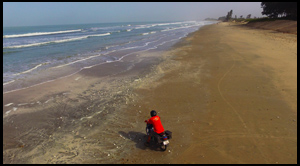Middle of the day a week ago, I start to feel feverish and fatigued. I considered what I had eaten in the past 24 hours. Had I poisoned my guts for the first time in Mali? Did I have a cold? Did I have the African cold?
The African cold is malaria and even with prophylaxis, you can end up contracting it. Five years ago, in Northern Benin (the same trip on which my leg would later become infected) I was introduced to malaria while watching elephants and warthogs in Pendjari National Park. I came down with a fever, didn’t make too much of it, and within eight hours found myself convulsing under blankets and wet towels. The Canadian missionary family we had hitchhiked with was stocked with Coartem, an anti-malaria treatment containing two drugs, artemether and lumefantrine, that effectively treat almost all cases of malaria. The mother of the family was a nurse and I couldn’t help but think “so this is how missionaries work” as she was feeding me Coartem, restoring my health, and telling me of the miracle that was unfolding: God brought you to us so we could treat your malaria and show you the light. I was to be healed on two levels. I did indeed consider the circumstances. But the miracle would soon be erased by a horrific leg infection I never would have suffered from if I had not been introduced to a certain waterfall by said missionaries.
Malaria is truly a sinister disease. Deep in a malarial fever, you feel like you are swimming in the Arctic Ocean while your insides are on fire. Sound like it would balance out? It doesn’t. The fever will relent, tease you with its absence, and then return violently. When it comes back, you know that millions of your red blood cells have just been vanquished and the Plasmodium protist is now looking for new real estate. Your body hurts. You are fatigued. You may be vomiting and shitting your guts out. And it can get much worse. Severe or cerebral malaria can kill you, and if it gets to that point you’ll want to be dead anyways.
In 2005, I was taking Lariam. It is a once-a-week prophylactic that is known for keeping malaria at bay while also proctoring nightmares and depression. I did have a few bad dreams on Lariam, but I also got malaria. None of the prophylactics are 100% effective. For Africa part II, I have been taking doxycycline, a once-a-day antibiotic that makes me exceptionally photosensitive. This time, I missed doses. When I visited lahou-kpanda, I forgot my doxycycline entirely. Oops.
Day two in Bamako and a fever coming on. I would keep an eye on it until the evening. Sure enough, the fever rose, broke, and then came back worse. I had a pack of Coartem as a back-up and I ate the first four pills. After the second dose, I am exhausted, but the fever is gone. By the third day, I am healed. Coartem cost me $12. A lot of Africans don’t treat their Malaria. Many have some genetic help, it’s true, but the main reason is price of treatment. If they do pick something up at a pharmacy, it will most likely be a few doses of malarone, another prophylactic that can also be used as a course of treatment, but certainly not for anything severe. Bill Gates is of course hard at work on a malaria vaccine, but this is tricky business because malaria does its work from inside our red blood cells, making an immune response very difficult.
Did you know there was malaria in the US as recently as 1950? Did you know the Center for Disease Control was started to eradicate Malaria? From the Malaria Policy Center:
Known then as the Communicable Disease Center, its work centered on the control and eradication of malaria in the U.S. It helped launch the National Malaria Eradication Program, a cooperative undertaking by state and local health agencies of 13 Southeastern states and the CDC. According to the CDC, the program primarily featured applying DDT to the interior surfaces of rural homes or entire premises in counties where malaria was reported to have been prevalent in recent years. By the end of 1949, over 4,650,000 house spray applications had been made. In 1947, 15,000 malaria cases were reported. By 1950, only 2,000 cases were reported. By 1951, malaria was considered eradicated from the United States.
More on the history of Malaria in the US here: http://www.malariapolicycenter.org/index.php/resources/a_history_of_malaria_in_the_united_states.
It is incredible to realize how quickly this disease was eliminated. The reason is DDT. While the widespread application of DDT came at the peril of Bald Eagles and surely a host of other species of wildlife, there is compelling evidence for measured, responsible DDT use in places where malaria is endemic.
From a New York Times article in 2004:
As malaria surges once again in Africa, victories are few. But South Africa is beating the disease with a simple remedy: spraying the inside walls of houses in affected regions once a year. Several insecticides can be used, but South Africa has chosen the most effective one. It lasts twice as long as the alternatives. It repels mosquitoes in addition to killing them, which delays the onset of pesticide-resistance. It costs a quarter as much as the next cheapest insecticide. It is DDT. …
No one concerned about the environmental damage of DDT set out to kill African children. But various factors, chiefly the persistence of DDT’s toxic image in the West and the disproportionate weight that American decisions carry worldwide, have conspired to make it essentially unavailable to most malarial nations. With the exception of South Africa and a few others, African countries depend heavily on donors to pay for malaria control. But at the moment, there is only one country in the world getting donor money to finance the use of DDT: Eritrea, which gets money for its program from the World Bank with the understanding that it will look for alternatives. Major donors, including the United States Agency for International Development, or Usaid, have not financed any use of DDT, and global health institutions like W.H.O. and its malaria program, Roll Back Malaria, actively discourage countries from using it. …
Malaria must be more than simply a line item in the health budget. Malaria kills tourism and foreign investment. It greatly reduces human intelligence and productivity and lessens agricultural yields. Against these costs, a nation’s business sectors and economic ministries should willingly join the fight — and donors must begin to think of malaria control as an unusually cost-effective antipoverty program.
South Africa’s success is inspiring another look at DDT around the continent. Uganda, Kenya and other places are now examining whether it could work in their nations. If it could, donors should encourage it. DDT is a victim of its success, having so thoroughly eliminated malaria in wealthy nations that we forget why we once needed it. But malaria kills Africans today. Those worried about the arrogance of playing God should realize that we have forged an instrument of salvation, and we choose to hide it under our robes.
You can read the article in its entirety here: http://www.nytimes.com/2004/04/11/magazine/what-the-world-needs-now-is-ddt.html
Reconsidering your thoughts on DDT? I am.
Big things to come. Camel drawing, Mali’s joking cousins, meeting Vieux Farka Toure?, Timbuktu, the Venice of Mali, and the world’s largest mud mosque. Inshallah.




Yo Phil- lovin the blog and am working through the archives. I took the once a week malaria drug while in Nicaragua a few years ago. Woke up in the middle of the night screaming and thinking I had been kidnapped and no one could convince me otherwise for several hours. Being in a rat infested, airless hut on the beach with no flashlight probably didn’t help. Ironically enough, now I take another form every day for arthritis. Those nightmares’ll get ya! Have an incredible time, b’hatzlacha 🙂
Hey Katie, good to hear from you. Glad you like the site. I’m sure your environment did not help, but I’m convinced the same could have happened in a 5 star hotel – Lariam definitely has some consequences for the psyche. You take another form of lariam now? And holy crap you are in Israel? You have a baby? Congratulations!!! Wow. He is a cutie. Great blog, I will be keeping up with your adventures. B well, Phil
Stay safe and have a good weekend–I love you. I am glad you are in favor of DDT. It could cure lots of sadness, for sure!
Sounds horrible. I think I am fortunate where as we don’t face anything like that in Turkey. The nearest is when people say they have the Turkey trots, and it is only because they have been drinking water with lots of calcium in it.
It is sad though, that a lot of African people can not afford the treatment. Judging from your description, it is heel going through maleria with no medication.
Hey Natalie, lots of calcium is no good. Kidney stones. One of my top ten greatest fears. Yes, it is indeed hell going through malaria w/o medication. Thankfully I have not had to experience this. B well, Phil
PS I love Turkey
Wow, I’m sure glad you’re better. It kills me that Malaria is a treatable disease and yet millions die from it. 🙁
Andi, thanks for the comment. I am indeed much better. Yeah it’s really frustrating knowing that so many people won’t even buy the $3 malarone treatment because they can’t afford it. B well, Phil
Hi Phil, great post on malaria! I did know about DDT (from National Geographic I think) and it’s a tragedy how many people die needlessly from malaria. In some countries people get it on average twice a year, and that’s with some genetic protection. I am interested personally as I may get a chance to visit Tanzania in the spring. After reading your story, I think I will take the doxycycline, skip the Lariam nightmares, and bring a box of Coartem around with me!
Jennifer, thanks for the comment. Definitely buy coartem. Doxy is not bad, a few side effects, but extremely cheap. Don’t think I would take it if I was doing serious long-term travel though. Have fun in Tanzania!! Take care, Phil